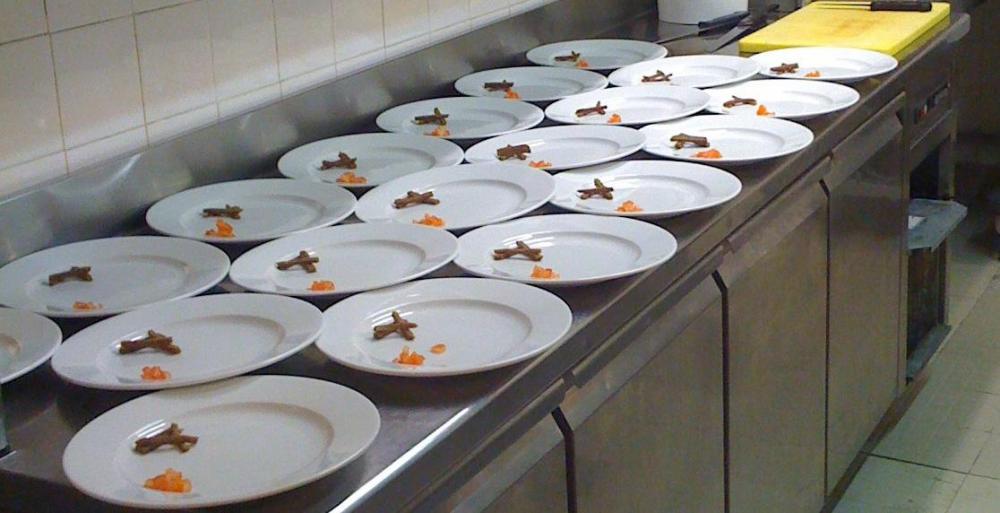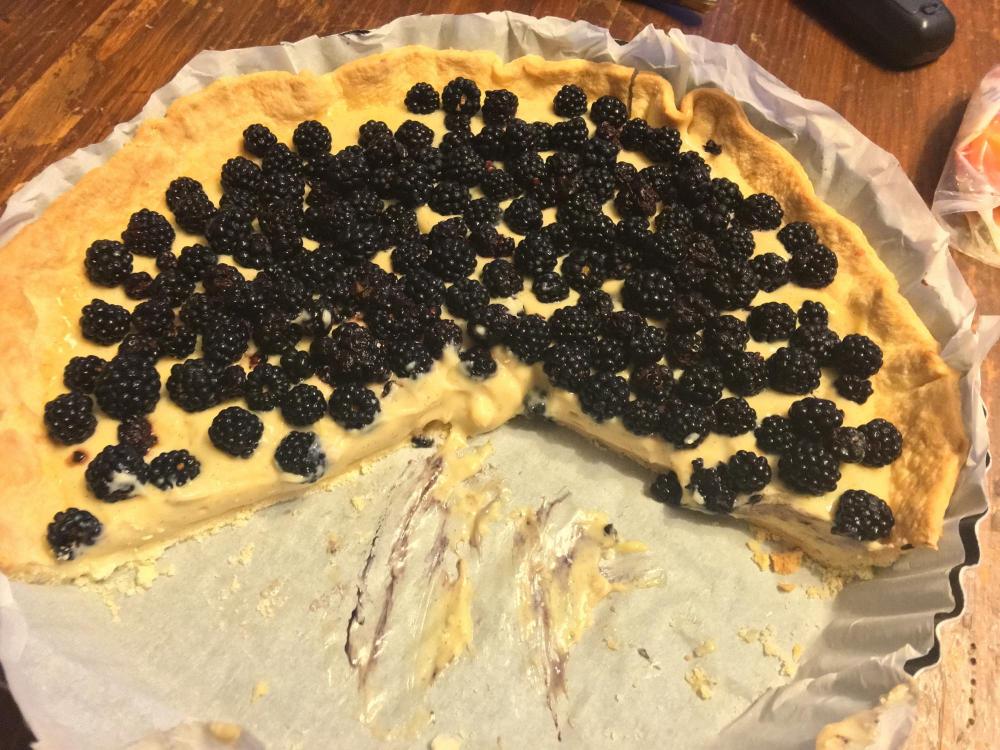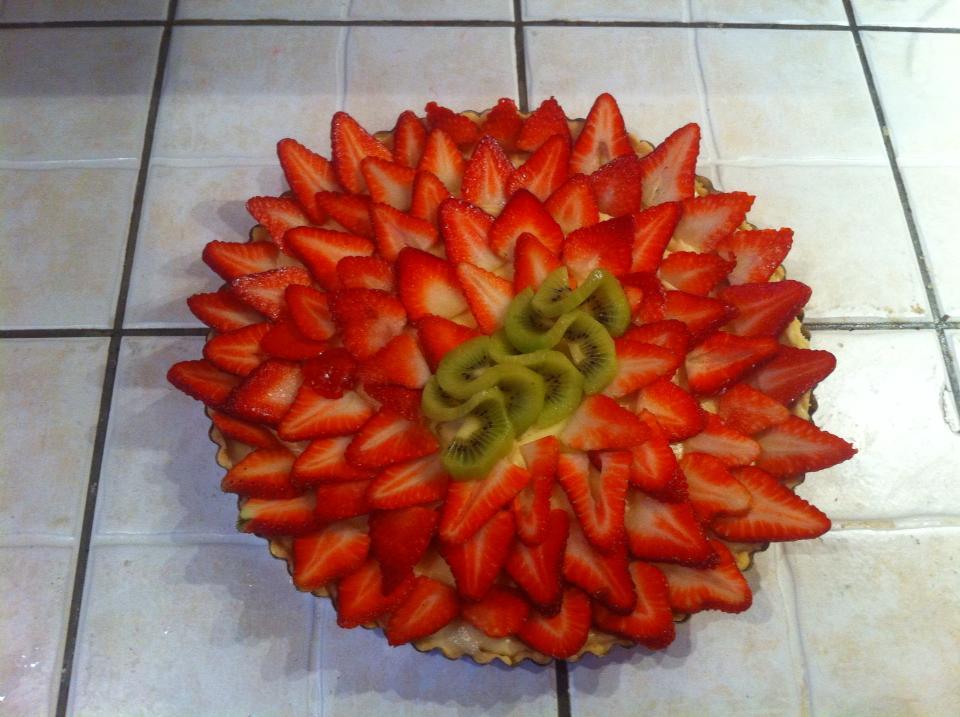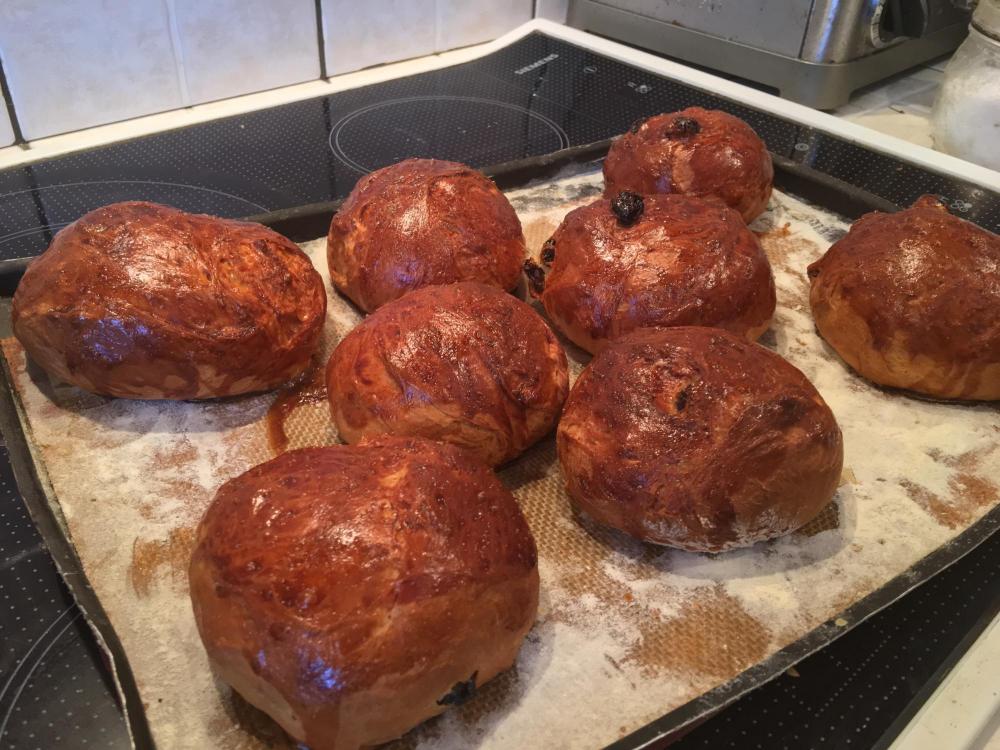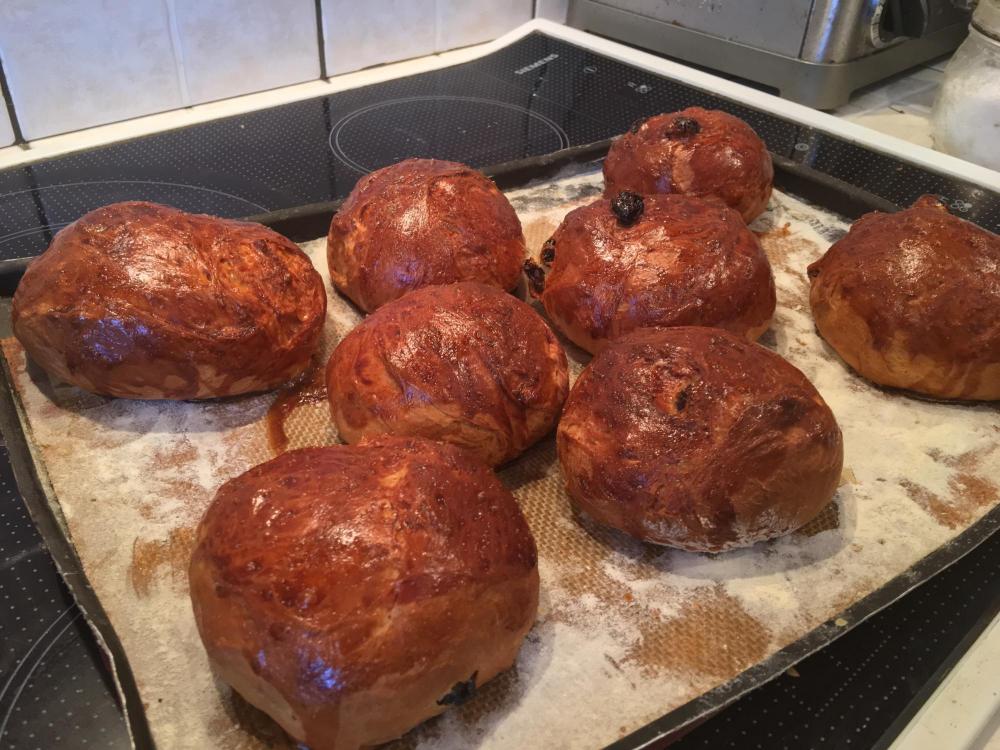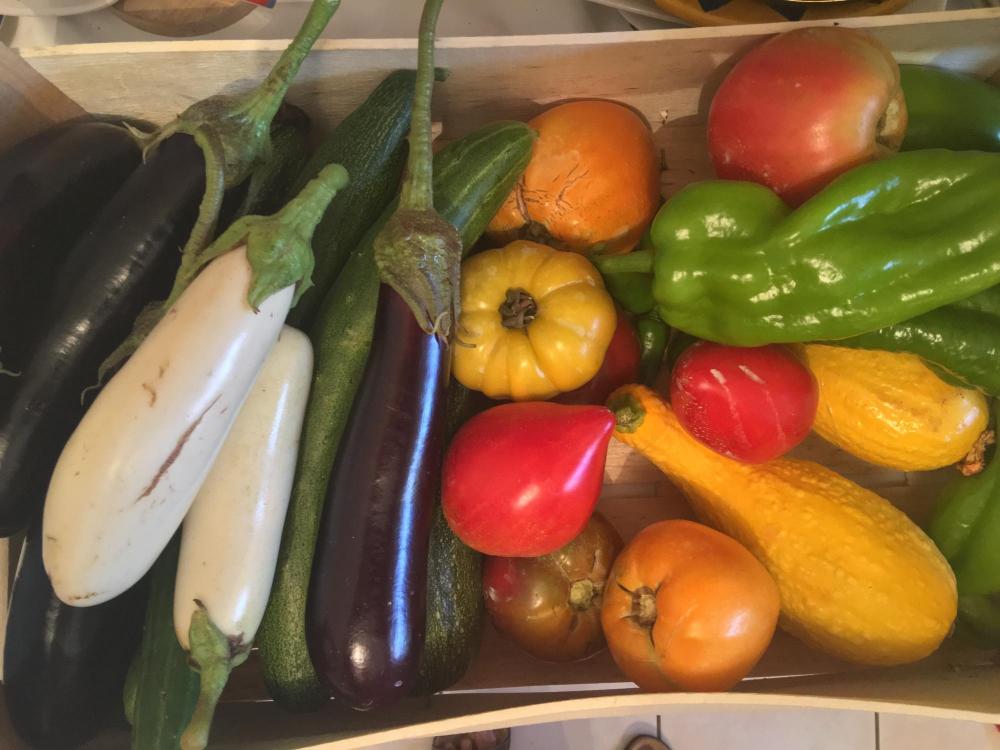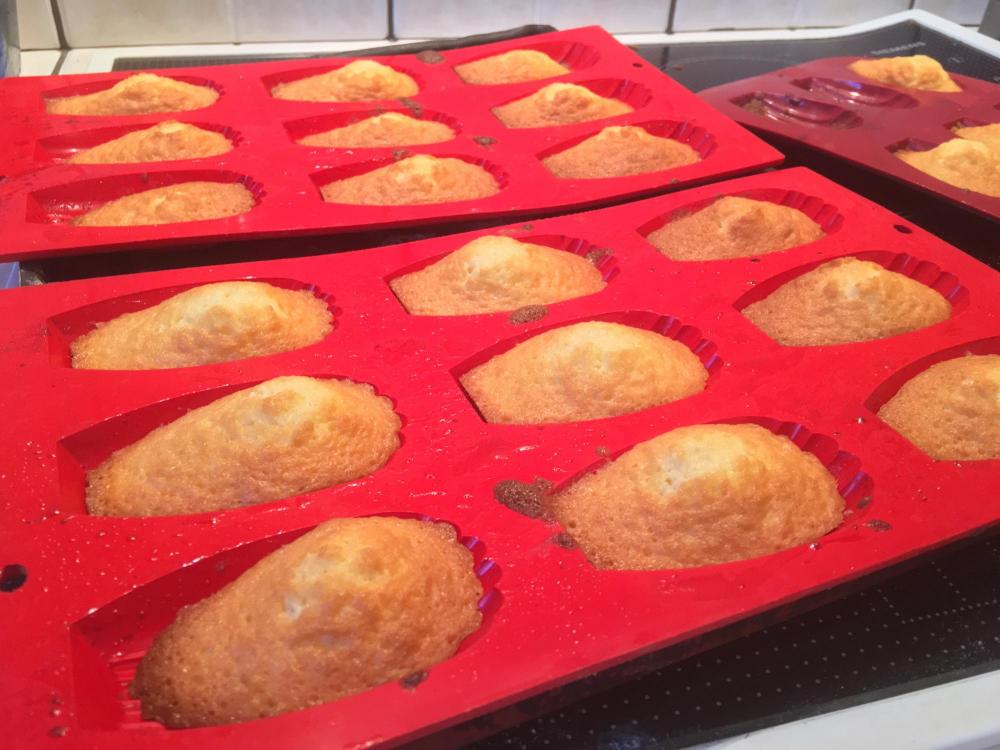-
Posts
162 -
Joined
-
Last visited
Content Type
Profiles
Forums
Store
Help Articles
Everything posted by Chris Ward
-
He probably said 'Dechire les feuilles' which means literally 'rip the leaves' but meant 'rip them off the stalk don't cut them' rather than 'rip them into little bits'. I will try the numbering thing, good idea.
-
The kitchen is manic or relaxed depending on the number of covers. Usually service (the period during which orders will be taken) is from 1200 - 1330, only 90 minutes, so cramming every order into that slot can be interesting sometimes. It's the waiters who get the worst of it, since the kitchen staff usually clear off at around 1400 (although the patissier may stay longer to do puddings) and the waiters have to hang around until the last clients clear off, often at 1500 or later. It's the classic swan swimming I suppose - serene on the surface, paddling like mad below the surface. I usually worked the starters station, so got hit first and quickest by the orders since people don't want to wait for their first course for too long, but I always enjoyed that. It was very good training for always having your mise en place spot-on ready, falter and need to do some prep in the middle of service and you're sunk. This picture shows you the extent I'd go to sometimes for a large group or table, setting up dozens of plates with decoration (this is just the start) ready for, say, a terrine and some salad at the last minute.
-
Thanks for the compliments, I'll post some more as soon as I can. Yup, gastros come in several - many, even - sized. I believe they may be called 'hotel pans' in the USA? Ah. And I got the size wrong according to Wikipedia: https://en.wikipedia.org/wiki/Gastronorm_sizes
-
Post 3: I stuck at it, despite the mistakes I kept going back to La Grange de Labahou every Thursday for several months, gradually getting better - or, rather, less worse - at the simple tasks Franck gave me. But I still made plenty of mistakes. This is a collection of some of the more memorable ones. Only young people have the luxury of knowing everything, simply because they know so little. As you get older the day finally comes when you realise that not only will you never know everything, the amount of stuff you will never know is increasing exponentially. Worse, there are things you didn’t know you didn’t know but thought you knew all along because they’re so obvious. Like, for example, how to wash a lettuce. Until I started working in a professional kitchen I’d never really given much thought to washing lettuces - rinse it under the tap, perhaps, pull off leaves, cut them up a bit without any method to the process. And then one evening when I arrived at La Grange, Franck asked me to wash half a dozen lettuces ready for the evening service. Greg, the sous-chef, seeing me eyeing them suspiciously, offered me some advice: Fill the sink with water, rip the leaves up, rinse them well and bring them over to my workstation he said. So I did. Except when he said ‘rip them up’ he didn’t mean ‘into the small pieces I put onto plates for the starters’, he just meant ‘remove the whole leaves from the stalk, don’t bother using a knife’. So I shredded half a dozen lettuces and was in the process of stirring them in a sink brimming with cold water when Franck just happened to pass by. ‘Why have you ripped up all the lettuces?’ Erm, well, Greg said…. It turns out that ripping them up like that bruises and discolours them and now they’re no longer fit to be served. Ah. Now, on one level this doesn't matter - half a dozen lettuces, total value about three euros, not many dead. Take it out of my wages. On the other hand it's 19h 30, the shops are shut and this is all the lettuce we have. Ah. See? Even washing lettuce isn't easy. There are plenty of other errors to be made: Washing up, for example - that’s not how you wash up. You scrape off the big bits and then put it in the machine. Sweeping the floor - you can’t use a broom because it raises dust and that’s now illegal in kitchens, you have to use a hoover and/or a wet mop which, in turn, is now illegal. You have to hose down, scrub with a stiff broom and squeegee; Beating eggs - where should I start? I can’t even crack open an egg properly, it turns out. For starters, you don’t crack them on the edge of a bowl because that can and will force small fragments of shell into the interior. And when you’re whisking yolks and sugar together your whisk should make a figure-of-eight pattern in the bowl, not round and round. And when you’re beating egg whites by hand the whisk shouldn’t go round and round the edge of the bowl in circles. Or in a figure of eight. It should lift up from the bottom, not vertically but sort of horizontally. Look, let me show you… When the waitress says No Chantilly she means No Chantilly on the profiteroles and not No Chantilly on the crème caramels as you thought, so now have to try to save an order of profiteroles with the unwelcome addition of whipped cream. And then I opened another new door onto a whole arena of errors I’d never even known existed before when I bought a book on the waitering side of this business, because I thought I knew a lot about the kitchen and wanted to learn a few of the basics out on the other side of the swinging doors. The book covered the CAP and BEP exams, roughly GCSE/High School level, with a suitably spotty youth in an ill-fitting DJ on the cover holding a covered tray, wearing slicked-back hair and a shirt two sizes too large. That sort of thing. The very first question in this book is, "In the ninth century the culinary arts changed in five principal areas, describe them." What? There's more. "Name the eight cheese families and give an example of each." Yes, I know - cheese has families? My favourite question is the one that gets you to replace negative expressions with something more positive - so, 'Je ne sais pas' becomes 'Je vais me renseigner' - 'I don't know' becomes 'I'll find out' - and 'Impossible' becomes 'C'est difficilement réalisable' - 'That will be difficult to do'. The best, though, is that 'Non' becomes 'Oui mais...' - 'No' becomes 'Yes but....' What it also tells me is that, in fact, I know sod all about cooking and kitchens. Sure, I know, now, where the ladles are kept in this particular kitchen and, yes, I can robot my way through producing a couple of dozen tiramisus. And to start with I was quite proud of my Tiramisu-producing abilities: In fact, I now make two dozen tiramisus every Thursday morning in an hour, down from an hour and a half back in May. I now also only use a dozen eggs, instead of the two dozen it used to take me - you have to separate the egg yolks and whites, something I didn't always manage successfully. If you have any yolk in the whites they won't rise properly. But then the only time my whites didn't rise properly was when Greg transferred them out of the mixer bowl into an ice cream glass while he used the mixer. I suspect the glass wasn't clean but luckily Chef had some spare egg whites about his person so I didn't have to crack another dozen. It's a sign of a good chef, don't you think, to always have a dozen spare egg whites about your person? But this is not really cooking, as I’m starting to realise. What about Menu planning? Meat preparation? Portioning? No idea. How do you calculate prices? Filet a whole Cod? Negotiate with the baker to get them to give you, for free, all their day-old speciality loaves to serve toasted with the foie gras? Should I do my own accounts or hire an accountant? ‘Give up’ is the only realistic answer I could come up with. So, I decided, I should do a proper apprenticeship and called whatever the acronym is for the French organisation which looks after apprenticeships. "You're too old," they said. "You need to be under 26". Ah, I said. So who looks after continuing adult education? This is, I think, the first time I've ever heard a shrug down a telephone line. Not their problem. Bah. To be continued....
-
The average French diner is usually pretty relaxed at home and in a restaurant. In restaurants it's very common for the Maitre d'hotel to warn the kitchen that 'Table six has only one hour to eat' to make sure we put a rush on their order. A lunch usually lasts 1.5-2 hours in a regular restaurant, 3 in a more gastronomic one. At home, my French family will say lunch starts at 12, arrive at 1 and spend an hour on the apero (aperitif drinks and snacks) and then finally stagger off home at 5 or 6.
-
Post 2: Jumping ahead a few years.... This article from my blog brings together the culmination of my years of professional cooking - the ultimate difficult thing for most people is not searing the perfect steak or baking the perfect madeleine, but getting everything on the table at the same, correct time without making your dinner party guests wait half an hour between courses. Recipe: How to cook Posted by EAT SLEEP COOK! on AUGUST 18 2014 OK, hands in the air, this isn’t really it’s a recipe. It’s how to cook any recipe from any cook book. Anything. Well, most of them anyway. Look. I was a terrible cook who thought I was OK, but I wasn’t. You may be a great cook, I don’t know, but most people aren’t and know it. And many who think they are, aren’t, but won’t admit it. The single most important lesson I learned becoming a professional cook was, “Everything you know is wrong.” Everything. That is not how you peel an onion. That is not how you wash up. That is, above all, NOT how you organise yourself. And it’s that last one I’ll address here (peel onions quickly taking away the top layer; scrape and rinse everything first before putting it in the dishwasher – there, bonus!) The real secret to working in a professional kitchen or giving a good dinner party is planning in advance – well in advance. Say, for example, you want to give a dinner party this evening. You want nibbles, a cold starter (don’t torture yourself here), a hot main, cheese and a whimsical pudding. OK. First, work out what time you’ll be sitting down to eat. Say, 8pm. Your cold starter needs to be ready, therefore, by 8pm. Your hot main course, say, 8.30pm, your cheese for 9pm and your whimsical pudding for 9.30 (we’re serving the courses in the civilised, French order today – not the heathen English version). Let’s say your starter is a gazpacho of roast peppers and tomatoes, since it’s easy and I know how to do that. Your main course is poached fish in sauce bonne femme (see Chapter 7) with steamed new potatoes and French beans (topping and tailing details in Chapter 1…). Cheese is cheese, just remember to take it out of the fridge at about 6pm. And your pudding is, I dunno, creme brulée. So, first tip: start yesterday. Or early this morning at the latest. Yesterday is best. Make your gazpacho – roast the tomatoes and peppers with a little olive oil, peel the skins off, de-seed the peppers and, if you want, the tomatoes, blend together in your needlessly expensive blender (I recommend the €9.99 stick blenders from Lidl personally). Done. Slice up a baguette or two, drizzle with olive oil, sprinkle with herbes de Provence, bake at 180C for about a quarter of an hour, voila. Croutons. If you did this yesterday you can think about your main course and pudding today. Well, make your creme brulées first. Get them baked this morning and pop them in the fridge, then all you have to do is brulée them with that expensive blowtorch you treated yourself to from that smart cookery shop. Lidl does them too, €9.99. So now it’s 11am and you have all day left to do your main course. If you’re up to it, buy your fish whole and fillet them yourself; if not, buy them whole and get your fishmonger to fillet them and give you the bones. Most fishmongers will be happy to give you a few other bones lying around too, so get enough to make your fish stock and get that made – see the recipe after Chapter 6. This, with a couple of finely diced carrots and onion, will be your fish poaching stock. You’ll need just enough to cover your fillets sitting in a shallow baking tray, a litre or so. You can add water if you don’t have enough. And, if you’ve bought new potatoes all you have to do is top and tail your french beans and you’re good to go this evening. So, 6pm. Take the cheese out of the fridge and put it where the cat can’t get at it. You could, if you’re a masochist, make your croutons at this point so the house smells like you’ve been working hard cooking all day, instead of lying in your garden hammock drinking rosé and reading the latest bonkbuster. Set the table if your lazy, idle partner’s too lazy and idle to do it properly. Have a glass of rosé. Do your kitchen mise en place. This means, get everything out of the fridge you’re going to need to be warm, make sure you have all the utensils and pans prepared and the oven turned on. 7.30pm. Put your fish stock in a saucepan with your GA (garniture aromatique – carrots and onions) handy already in the poaching pan with the fish. Cover to keep the cat out of it. Boil the kettle and put your potatoes and beans in the steamer, ready. In between welcoming your guests, turn on the oven so it’s nice and warm. When you pop into the kitchen to collect the gazpacho from the fridge, set the stock to boil, then cover the fish with it and pop it into the oven when you’re clearing the starter bowls. Put the boiling water in the steamer to cook the vegetables. Depending on the thickness of your fillets they’ll take between 5 and 10 minutes to cook. Check after 3-7 – it’s easy to put them back in, not easy to un-cook them. You want them slightly underdone. Take them out of the stock, put them in a warm place (NOT back in the oven!) and put the cooking juice into the original saucepan to boil it like mad – see the sauce bonne femme recipe after Chapter 7 for the details on making the sauce. You can flavour this sauce with, say, some chopped chives, dill or chervil – add the herbs at the very last moment just before napping the fish. Whilst everything’s boiling and steaming you can spend another five minutes with your guests, just so they don’t get to finish off your rosé all to themselves. Back in the kitchen spread the WARMED plates out (put them in the oven when you take the fish out), pop a fillet on each plate, nap on the sauce, add the strained vegetables attractively (towering displays are out this year, very 2007, as is smearing and foaming), serve. Then the cheese. Then brulée the puddings. Planning and preparing in advance – write your timings down is a good piece of advice, I had to do it for my professional exam – is the way to go. Make sure you have everything to hand BEFORE starting any recipe or plating, too. What could go wrong?
-
Post 1: How I got into this A long time ago, a lifetime ago in fact, I became a cook in self-defence; my mother was a school canteen cook. Head cook, in fact. She cooked all day at school - 1,600 covers! all from scratch! - and couldn't face cooking at home. My father was old-school, sitting at the table impatiently tapping his knife and fork for the food to magically appear. My sister was younger than me. So either I cooked or we starved. So I cooked. And on through my life I cooked all the time, for friends and flatmates and everyone who came to my house. Lunch, breakfast, afternoon teas, dinners, snacks, whatever. I am the cook for everyone who knows me. And then we moved to France and bought an old farmhouse in the middle of nowhere and then got divorced and sold the farmhouse and I got bored with the journalism career I'd been working at for 25 years. "Open a restaurant," everyone said. "You can cook." Right. The following is the start of a story I wrote a couple of years ago about how it all happened, a story which eventually became a book, a film, a major TV series starring Craig Daniel as me and Helen Mirren as Anthony Bourdain. Wait, some of that's not true. Here's the start of the story. I'll post more when I get a chance and if there's a demand. Prologue: Asking to be a plongeur Posted by EAT SLEEP COOK! on JUNE 22 2014 Prologue It all starts, as do so many lunatic ideas, with lunch. Because I had so much free time on my hands as a journalist I’d started a book club for local ex-pats and we met in my favourite local restaurant, La Grange de Labahou, in Anduze, Gateway to the Cevennes mountains. We were discussing Toast – The Story of a Boy’s Hunger by Nigel Slater, and a right disappointing read it was too. And, interesting though the book club is, and good though lunch is (foie gras maison – well please, it was on the menu, what could I do? – fricassée de pintade au cidre, poire au vin) the best portion of the event came when I chatted with Isabelle about my upcoming inscription at Vatel, the big hotel and restaurant school in Nimes to further my dream of becoming a professional Chef. Which, I told her, was going to cost a fortune – five grand a year and how am I supposed to earn a living at the same time? Well, erm, I added, I was wondering would it be possible to come here and work as a plongeur? Isabelle, who runs the front of house while her husband Franck cooks, laughs. I say I’m serious, I’d love to work as a washer-up in their kitchen if they’d have me, I very firmly believe in starting at the bottom and, come the glorious day when I get to run the People’s Kitchens at the palace formerly known as Buckingham, I don’t want to be ordering some former toff to scrape dirty saucepans if I’m not able and prepared to do the same myself. It turns out that they don’t actually need a washer-up, they already have one and he only comes in on Saturdays when they’re really busy, she says – the rest of the time Franck and Greg, his sous chef, wash up as they go along. But, suggests Franck, come along for a day a week and work here anyway, to see how you like it. Get a feel for the business and see if you like it before splashing out on the Vatel course. Some short discussions later and it’s arranged: I’m to be given a foundation course in doing things in the kitchen Franck’s way in return for teaching them some basic English. Neat! So, says Franck, see you next Thursday, wear sensible, enclosed shoes, trousers that don’t matter (this doesn’t narrow down my wardrobe much) and I can borrow one of his sous chef Greg’s chef’s coats. Cool. What could possibly go wrong? 30140 Anduze, France Chapter 1: Day 3 Posted by EAT SLEEP COOK! on JUNE 22 2014 Chef stands me in front of a big bowl of fresh, green French beans, haricots verts, a plastic cutting board and a knife. “You can start with these,” he says before moving off to start doing something serious to the lumps of meat that have just arrived. Now, I’m not daft. I’m not stupid. I’ve done French beans before, lots of times in fact. Since I was a kid on my granny’s knee in fact. Ha! You just sort of break off the tops and tails between your thumb and forefinger, trying to pull the string that sometimes peels down the side as you do so. Right? But. But. There was the cutting board and the knife next to the beans, so obviously in proper restaurants one cuts the ends off beans on a cutting board. I mean, the one thing I’d learned since becoming a ‘professional’ chef was that everything I thought I already knew about cooking was wrong. So I set to with the knife and board. At first I cut the beans one at a time but then – having thought about this – I realised that I could be more chef-like and cut several at once. Saving time, doing things quickly and efficiently is the other thing I’d learned since becoming a ‘professional’ chef two days ago. I was just lining up my second lot of half a dozen beans when Chef passed casually behind me. He was very good at wandering by apparently casually, as if on his way somewhere else and not at all checking up on my stupidities. “First,” he says, “we don’t use a knife to top and tail beans here – you do it with your thumb and forefinger, like this.” He demonstrated, showing me the bean top-and-tailing method I’d been taught by my grandmother 40 years ago in between her egg-sucking lessons. “Well yes, obviously,” I blurted. “That’s how I’ve always done them but you gave me the board and the knife so I thought I was supposed to use them instead.” “And secondly,” he continued oblivious to my blurtings, “that is not a cutting board. That is a sheet of frozen puff pastry I’m going to use to make the millefeuilles for dessert with when it’s defrosted.” Ah. Millefeuilles of green beans, anyone? Ahem. This is the start of my third week – well, third day as I’m only here one day a week – in a restaurant working as a ‘professional’ chef. I say ‘professional’ like that because I’m actually not a Professional Chef. Not even a professional cook. I feel like a culinary tourist, peering into the real world of restaurant cooking as if I were a fat tourist poking my camera into a mud hut in some distant land. I’m here because I think I want to become a Professional Chef, open a restaurant and have a Macaron – a Michelin Star (us chefs call them Macarons because the symbol in the Guide Michelin looks a bit like a macaroon) – within five years. Three by the time I’m 50 in seven years time. Some hope if I can’t spot a sheet of puff pastry at arms’ length. My desire to become a chef goes back to my childhood, when my school dinner lady mother said becoming a cook would be a waste of my public school education, and more recently to my 40th birthday party in Paris in October 2000. While everyone else was off seeing the Eiffel Tower and getting their portraits painted in Montmartre, I spent a morning watching a class at the Cordon Bleu cookery school. It was a blindingly revelatory moment, the sort that, were I driving towards Damascus, would have been accompanied by flashing lights and heavenly voices saying, “This is the life for you my boy!” I wasn’t put off by the hordes of foreigners taking the Cordon Bleu class (mostly Japanese and American teenagers who had to have simultaneous translation of the French chef patissier’s instructions for making a red-fruit charlotte), in fact I hardly noticed them; I was simply entranced watching the chef working, how precisely and authoritatively he did every single thing and the beauty of the final product. I was also entranced by the equipment he got to use, in particular the pantry cupboard-sized fast chiller he used to cool down the two cakes he’d made so they’d be suitable for tasting at the end of class. And he looked so damned cool in his kitchen whites. Even his toque looked cool. This, I agreed with the blinding white light and the heavenly voices, was the life for me. First, though, my future ex-wife and I had to move house, split up, get divorced and sell the old stone farmhouse dream home we’d bought in the middle of nowhere in the South of France, a process which took us through to just after Easter, 2004. By which point I’d worked out that I couldn’t afford to go to the Cordon Bleu school in Paris – apart from the €30,000 annual fees there were the questions of where to live for a whole year and how to earn a living whilst going to school full-time. So I’d found the Vatel school 40 kilometres away in Nîmes, which would take me on for a more reasonable €5,000 or so. They did a one-year ‘Masters’ course which, most interestingly to me, included nine months of ‘Stages’, work experience courses during which I’d be paid a basic wage of about €450 a month (see, maths has never been my strong point – I pay you five grand so you can pay me a €4,000 salary…). I visited the school and was warmly welcomed, the school director telling me that I’d have my pick of the Stages because most people doing this course wanted to be ‘future Club Méditerranée managers not cooks’. All the famous former pupils welcomed people like me into their restaurants, she said. It sounded good. All I needed was five grand which, since we were selling our house and going to make an immense profit, would be easy. I’d have plenty left to live on and set up a fantastic restaurant – that Macaron was as good as mine and I was already well into choosing the china and cutlery. A voice of reason did begin to intrude at this point though – I knew how to cook up a good dinner party but everyone said that restaurant cooking was completely different. Be careful, they said. People always say things like this because it’s what everyone says, and coincidentally they’re right. So one day after a good lunch of foie gras maison, fricassée de pintade au cidre and poire au vin at La Grange de Labahou in Anduze run by Franck and Isabelle, in the Spring of 2004 I chatted with Isabelle about my upcoming inscription at Vatel and, er, could I come here and work as a plongeur (French for dishwasher and kitchen porter) to get a bit of experience? My first day in my new life as a chef was, appropriately enough, April 1st. I had both great hopes and fears for the day – I hoped I’d adore it, I fervently hoped I wouldn’t make too many stupid mistakes and wished that the others working there would accept me as a potential future colleague and not see me as a culinary tourist. But I feared I’d find the work too difficult, too tiring and that I’d make endless, clumsy mistakes. I’d managed to find some trousers that didn’t matter, although at the time I was 40 kilos into a giant diet which meant that my trousers kept falling down around my ankles. The 40 kilos I still had to lose meant that I could barely button sous chef Greg’s old chef’s jacket over my stomach but an apron hid the worst and helped hold up my trousers. The first surprise was that that kitchen team in full was just Franck and Greg, with a dishwasher on Saturdays. Blimey. And the two of them do up to 100 covers a night. I’d eaten at La Grange before, and in their previous restaurant Les Terrasses d’Anduze in the centre of town, and I’d never guessed how they did it or that there are only two of them. The very first thing I got to do was to peel five kilos of oranges to make marmalade, and the very first thing I learned was: Everything You Know Is Wrong. You don’t peel oranges by trying to stick your thumb nail into it, you do it with a knife. A knife? To peel an orange? Look, says Franck, and he deftly cuts off the top and bottom of the orange then trims the peel off down the sides leaving no flesh on the peel, wasting nothing.Then it’s all cut into equal-sized pieces and goes into the pot. In about 10 seconds flat That ‘equal sized pieces’ thing will haunt me over and over again over the next few years; any Chef who wants to have a go at an underling will watch them cutting something up. Then saunter over – Chefs do ‘Saunter’ very well – and pick up the smallest and largest pieces of whatever it is you’re cutting up apparently at random. They can spot them within half a second, and all they have to do is hold them up in front of you while raising one eyebrow for you to know what a loser you are. And then there’s the whole ‘peel just the peel not the fruit’ thing. With orange marmalade it doesn’t matter so much since it all goes into the marmalade, but again Chefs have a way of pulling peelings out of your waste bin and explaining to you just how much you’re adding to their food costs by THROWING THE INGREDIENTS AWAY. So here’s a tip if you do ever find yourself in a professional kitchen and don’t want to look like a complete idiot: EAT your mistakes. Even thick peel. And you may even get away with it, until Chef brings out the weighing scale and wonders how come you started with five kilos of produce and now only have four. Feeling hungry are we? Franck, though, isn’t that kind of Chef and, once he’s over his initial reluctance at having any sort of tourist in his kitchen, is happy to chat about the differences between French and English cooking. Like the way he’s boiling the oranges first – I’m pretty sure Grandma never did that when making marmalade. Chutney comes next, with Franck making his famous Dried Apricot Chutney, the one he serves with the foie gras. The recipe is disturbingly simple, just vinegar, water, cinnamon, cloves, a few raisins and the dried apricots. Let it cook very gently for two or three hours and voilà, chutney. During the preparations and the mise en place, a lot of commercial representatives arrive to show their products – they normally arrive on Mondays or Thursdays, says Franck. One’s selling pre-cooked dishes – no interest here where everything’s home-made; then a couple of chaps who sell kitchen equipment – one of them makes plates, bowls and other such things in, incredibly, Stoke on Trent in England, “The Limoges of England but bigger,” he explains. There are some very interesting things including sloping bowls, with one side higher than the other. And black ones, long plates suitable for fish but all expensive. Wait until next year, says Franck, they’ll all be half-price. Talking of fish, he shows me his ‘bassin’ full of trout and crayfish; dozens of fish in a 10-metre square by five metres deep concrete basin. He’s in the middle of draining it – it takes four days – to refresh the water. Eventually the trout will be served in the restaurant. Then a little washing up for me, and what a washing up machine they have here; the size of a regular domestic washer-upper but at sink height. You slide a plastic tray of plates, saucepans and whatever in, lower the lid and one minute – yes ONE MINUTE later everything is clean and dry…I really want one of these in my kitchen at home. Only five grand. The other thing I want is the steam oven; you can control both the temperature and the humidity and voilà, everything is perfectly cooked. Incredible, and not badly priced either – just €30,000. More work: I cut up the strawberries and give them a whiz in the robotchef, then add sugar. Then add more sugar to correct my mistake… And then I put the potato purée in a giant tray – it’s called a gastro, short for gastronorm, I discover later because it’s a normal size for gastronomic cooking, 70×40 cms – scooped ice cream for the puddings and squirted red-fruit coulis. The day just got better and better. No really, I loved it. The only real mistake I made that first day – at least, the only mistake that I saw myself – was to break two of the poached eggs I served while cutting them into round shapes and putting them on a plate. Oops. And then really before I realised it service was over and we dine together, Franck and Isabelle and I – the duck breast with pepper sauce from the menu then some cheese. You know, I could do this for a living… 30140 Anduze, France
- 111 replies
-
- 17
-

-
Apparently I shouldn't just post a link to where I've written up the story about this tart, so here's the whole deal with even more apologies! We (OK, OK, my wife) picked a sack of blackberries when we went for a walk along the old railway line the other day, and she's been hassling me to do something with them ever since. Like, she said, make a tart. With crème patissiere. And pâte sablé. Well, me and pastry - as they say in French - that makes two; I can't, won't make it. I buy it. And pre-made chilled pastry here is nicer than anything I can make myself, so good that people believe me when I say I made it myself. So I bought a 30cm round of ready-made pastry and blind-baked it, 25 minutes at 180°C turning it two or three times to ensure even cooking. Don't forget to repeatedly stab the base with a fork to stop it rising. And don't forget to put in your baking beans like I did - this forgetfulness leads to the sides sagging down. While this is cooking, make the crème patissière: for a tart this size, use 500ml of milk, 100g of sugar, 5 egg yolks, 70g plain flour, a vanilla pod and a pinch of salt. Put the milk on to heat with the split/scraped vanilla pod (put the whole pod into the milk to infuse - lots of the vanilla flavour comes from the pod itself rather than the seeds). Whisk together the sugar and egg yolks to the ribbon stage (lift up your whisk and trail the dribbles across the surface of the mix - it should stay in place looking a bit like a ribbon for a second or two). Then whisk in the flour thoroughly. When the milk boils, pour a little into your flour/sugar/egg mix to make it liquid, then add the rest stirring all the time. When it's thoroughly mixed, pour it back into the saucepan and gently bring it to the boil. Stirring ALL the time, or it will go lumpy. Bring it back to the boil and simmer it for a couple of minutes to thoroughly cook the flour, then decant it into a clean bowl, whisking all the time to avoid those lumps. When it's cooled a little, cover the surface with a layer of clingfilm (may be called Saran wrap in your part of the world) and refrigerate it. The plastic film stops a skin forming on top. At catering school we learned to dab a little butter onto the surface to stop the skin forming; my restaurant chef, after looking at me like I was a Martian when I suggested doing this, showed me the clingfilm method. When everything has cooled down, check your crème for lumps. Whether there are any or not I like to whisk my crème patissière with an electric whisk at this point to make it easier to handle - a couple of minutes with the electric mixer and it'll pour easily into your pastry case, allowing you to smooth the surface nice and flat. Then put the blackberries on top. In this example I've used the artisanal 'higgledy-piggledy' method, i.e. I just poured them on top, roughly smoothed them into a more or less even layer and then tucked in. If you have time and patience you can make them look more artistic, like this one I made earlier (three years earlier, in fact, that's how often the mood takes me to take the time to do it properly). One last note: for various reasons (OK, I'm lazy and it was the first packet that came to hand) I used brown, less-refined sugar to make this crème patissière and it turned out very well, a subtly caramelised taste which is very pleasant.
-

Your Daily Sweets: What Are You Making and Baking? (2016 – 2017)
Chris Ward replied to a topic in Pastry & Baking
The blackberry tart is the one I made yesterday from blackberries we picked (OK, my wife picked) while we were out walking. The strawberry one is the one I made three years ago, the last time I had the energy/inclination to make one of these crème patissière tarts look pretty. Full recipe at https://eatsleepcookschool.wordpress.com/2016/08/21/quick-hedgerow-tart/ As always, I am in awe of the skills you folks demonstrate here.- 489 replies
-
- 13
-

-

Your Daily Sweets: What Are You Making and Baking? (2016 – 2017)
Chris Ward replied to a topic in Pastry & Baking
A long time ago the chef patissier I worked with used to sprinkle cocoa powder, cinnamon powder and other goodies on his tiny, delicate meringues; then one day he tried doing the sprinkling before cooking and the results, especially for the cinnamon ones, were fantastic. Obviously this won't work for all the things you've done here (which look absolutely fantastic) but I recommend it especially for spice powders. -

Your Daily Sweets: What Are You Making and Baking? (2016 – 2017)
Chris Ward replied to a topic in Pastry & Baking
Wow, some very handsome patisseries here - they make my buns look positively boring. These are pretty similar to the buns I used to get from my school tuck shop back in the 1970s. Very moorish. Recipe here: https://eatsleepcookschool.wordpress.com/2016/08/17/brioche-buns/ -
They are white aubergines/egg plants and, yes, that's a tomato of 'varieté ancien' - the old kind, says Ben. I don't know what variety the peppers are, I'll try to ask him; mostly he's using a 'regular' seed type but which has no special chemicals or, in particular, lots of extra water to pump them up and make them huge. The tomatoes are large but are full of flesh, not water, and are great value. I ended up making a 'wet' ratatouille by baking the veg under a rotisserie chicken - wet because I poured in a litre of veal stock. This made for a fantastic sauce which my daughters loved. Sorry I didn't take any pictures of the ratatouille, I'll get some next time.
-
Better known as a ratatatatatatouille to my kids. This is the vegetable box we get for €10 from my wife's cousin Ben at https://www.facebook.com/profile.php?id=100009373217380
-
I've written up the whole recipe here: https://eatsleepcookschool.wordpress.com/2016/08/07/non-proustian-madeleines/
-
Sorry this took so long to post, holidays got in the way of baking. I know, I know, I'll adjust my priorities in future! These are 3 pictures of the madeleines I made yesterday, in the silicone molds. As you can see, the upper surface browns the same as in the metal molds; the underneath not at all, except when I left them in a couple of minutes too long. This is the process I've always used working here in professional restaurants and how I see them everywhere now. I guess if you want both sides browned you need to go for the metal molds? My recipe: 500g sugar 400g flour 400g butter 9 medium eggs 1 sachet baking powder (7g) Zest 1 lemon This is enough for about 100 madeleines (it was to make a platter of iced ones for my daughter's 6th birthday. And we eat them for breakfast too.)
-
When I asked the posh daughter of friends in Hampstead, London (the poshest part of North London) if she enjoyed her school dinners she replied, "We don't have dinner at school. We have lunch." You may need to be English to LOL at this one.
-
I thought this might amuse some of you - it's what my children eat at school. The rules for constructing the menus are quite strict, with norms for the types of protein and vegetables being set down for all menu planners. This menu is produced for my children's school and several others in the region by a local 'traiteur' - a catering company. They have to offer 'bio' - organic - items four or five times a week, for example. The kids love it, too. Many years ago I covered a strike by pupils in a private school in Paris because their school menu - the horror! - had a choice of only TWO cheeses! Ours is a state school so there's no choice. Oh how they suffer. They do get a starter/main/cheese/dessert every day, though. CCPS-Restaurants_Scolaires-Menu-Juin-2016.pdf
- 1 reply
-
- 1
-

-
Some people are spending a lot of money on machinery....I bought a Gran Gaggia about 20 years ago; the disadvantage is it's only a single boiler so steaming milk in the morning can mean a wait. The advantage is it's cheap(er) than other 'home' machines. It's paired with a Cuisinart grinder (which needed slight hacking to produce a fine espresso grind) and the whole deal cost about €300, which is plenty expensive enough for me. The Gaggia has been serviced a couple of times and had a few gaskets replaced but it's still going strong. For a while when the Gaggia was broken down I used an Aeropress which, for about €25 produces a very nice coffee.
-
All the restaurants I worked in used whatever the coffee machine supplier brought round. Many places rent their machines cheap or for free on the understanding that they buy their beans from the machine supplier. Many suppliers make up their own mixes from half a dozen different beans and most are fine. I still buy my beans from a roaster in Avignon near where I used to work. His 80/20 arabica/robusta blend from, usually, Vietnam/Mexico/Columbia/other Central American countries is always excellent.
-
Semi-skimmed (2%) works best since it's the protein content, not the fat content, that promotes frothing (cf McGee); the protein is in the milk, not the cream, so less cream=more protein. If you don't have a steam wand, I've successfully used this technique: Heat the milk in a microwave (borrow your neighbour's if you're too posh to have one) to a bit over your required temperature. Place a sauce whisk vertically in the jug you used and 'roll' it between your vertical hands as quickly as possible for as long as you can. Do it for long enough and you get a nice micro-texture.
-
Looking through earlier posts, many people seem to come to Paris, eat in the great restaurants with lots of Michelin stars and then move on. May I recommend taking the TGV south to Montpellier and then taking a taxi out to Bouzigues, where a shack on the beach next to the family oyster packing shed will serve you oysters just pulled from the sea? Very tasty. I'm sure Nova Scotia has equally interesting offerings.
-
I have actually never, ever used steel molds - not at home or in restaurants. In restaurants I never even saw them, let alone used them, and the thought never occurred to me to buy steel ones for home therefore. I'll see if I can make up a batch today.
-
Not particularly. I'll post a picture next time I back a batch in the silicone molds.


